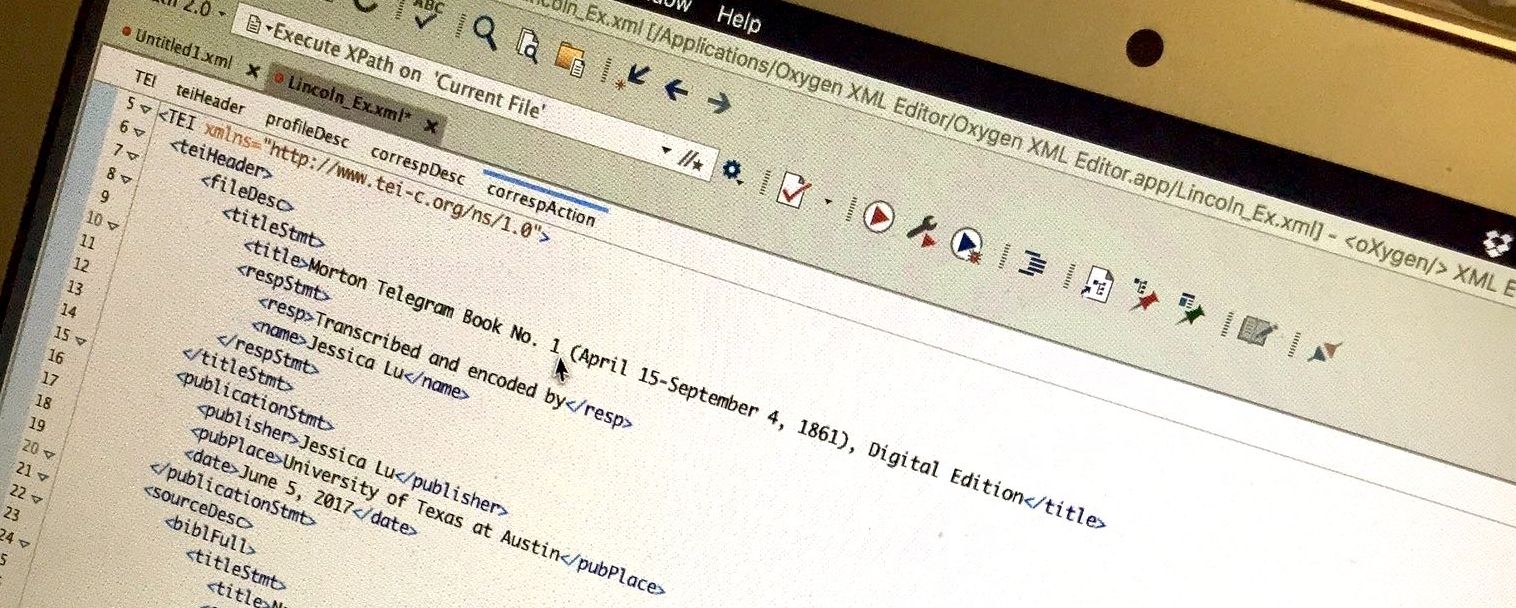Confronting “the Witness”: Encoding Archives of Black Lives | Jessica Lu
When we centralize blackness and black lives, it is impossible to ignore how encoding is also a critical site of power.

As a rhetorician, I am trained to analyze public discourse and the history of ideas. My critiques focus on “progressive” ideas—like freedom—that are leveraged by the state to codify exclusion, surveillance, and dehumanization of blackness and black people. As a graduate assistant to the AADHum initiative, I am exploring how I can engage with digital tools to push my work beyond single- or several-text analysis and make my work legible in interactive formats. Learning how to encode archival documents is a crucial first step, because it transforms them into “machine-readable” texts that can be used for digital representation and analysis. This “transformation,” however, can easily sustain unjust practices of silence and erasure in historical documents. In order for encoding to make new arguments and critiques possible, we must confront exercises of power and violence in the archives of black lives.
I was introduced to encoding in the Introduction to the Text Encoding Initiative (TEI) for Historical Documents course at Humanities Intensive Learning & Training (HILT). Our instructor, Caitlin Pollock, threw us into the deep end of the TEI guidelines. With her guidance, we learned how to comb through documents and create tags that assign status, names, types, and other identifiers to people and places. We grew more adept at searching and applying them, until Oxygen flagged fewer and fewer errors when we encoded full headers and short documents.

While encoding fits some of my pragmatic goals, learning more made it increasingly clear that exercises of power are deeply embedded in markup practices. Its reliance upon American English highlights the colonization of programming by romance languages, and it has limited capacity for encoding race and gender (e.g. Hannah Gillow-Kloster’s effort to encode Virginia Woolf’s Orlando).
Other concerns weighed even more heavily as I reflected specifically on blackness and black people. What struck me most was the focus on preserving the content and form of the original document, troublingly called “the witness.” The TEI guidelines prompt you only to encode what is there, but institutional documents and state memory projects relentlessly silence black people and black voices. How would I encode the pages and pages of Freedmen’s Bureau records that identify black people only by color, rather than by name? How should I mark up the tables and charts that account for black people only as bodies—as slaves, assets, or cases to be resolved—rather than human beings? What identifiers would, could, should I assign to them?
Recalling Saidiya Hartman’s struggle to honor traces of Venus, I realized the urgency of care in archival work is exacerbated, rather than mitigated, by encoding. TEI has limited options for identifying that which is not there, yet certainly there. Imagine the complexities of encoding documents in which black people are spoken of and for, but never named. Surely we cannot presume to speak for those whose voices are merely recorded as whispers. Yet, to forgo markup for them would confirm their erasure. Alternatively, encoding their names, status, or traits as “unknown” reaffirms the state’s power to dictate and control what is worth knowing about black people—past and present. How can we challenge TEI to account for silence and erasure of black people, especially as more and more of us are recognizing the need to #saytheirnames?
TEI’s emphasis on consistency with “the witness” is a significant hurdle. TEI invites us to treat a document as a “hierarchy of content objects,” mine and identify its elemental parts, and encode it so that the document’s “true” form is retained. The guidelines neglect the exercises of power and identity that create those hierarchies, let alone how encoding can recreate them. Without addressing how form itself can enact violence, TEI “violates some of the most basic reading practices of the humanities community.” Ultimately, we risk encoding, digitizing, and preserving violent archives that continue to exert harm. Bergis Jules reminds us, practices of digital preservation have “real consequences for marginalized people because who is remembered and how they’re remembered dictates who gets violence perpetrated against them.”
I believe that we can challenge digital tools and exercise greater care in using them. The TEI guidelines may lag behind; they are maintained by a consortium that is subject to extensive economic gatekeeping. Costs associated with membership, software, DH trainings, conference travel, and research funding limit who can learn TEI and push the guidelines toward meaningful transformation. In the meantime, Caitlin stressed that individual encoders can build work-arounds, like crafting original schemas and inventive tagging practices. But XML markup and finished projects can obscure the complex layers of meaning-making and critical interpretation embedded in the encoding process. How will we be able to share with and learn from others if our personal work-arounds remain just that: personal?
In the great expanse between encoding and finally publishing a digital project, I hope we can find one another in collaboration and community. We stand little chance of challenging the issues that remain embedded in TEI’s guidelines if the work is not made visible in process, as well as documented thoroughly in the final product. More importantly, we risk the (re)creation of digital archives that sustain the egregious violence of traditional ones.
I am just beginning to learn how to make encoding work for me and my research. I will continue to seek the guidance of experienced encoders, because TEI is a vital tool for discovery, access, exploration, and analysis. But, when we centralize blackness and black lives, it is impossible to ignore how encoding is also a critical site of power. TEI’s guidelines must not only be challenged and adapted, but transformed to address silence and erasure in both historical and contemporary documents. Only then may we be able to reimagine what is possible for traditional and digital archives.
—Jessica Lu, Doctoral Candidate and Graduate Assistant to the AADHum Initiative, with gratitude to Caitlin Pollock, Dr. Jovonne Bickerstaff, and Kevin Winstead for their contributions to the development of these ideas.
